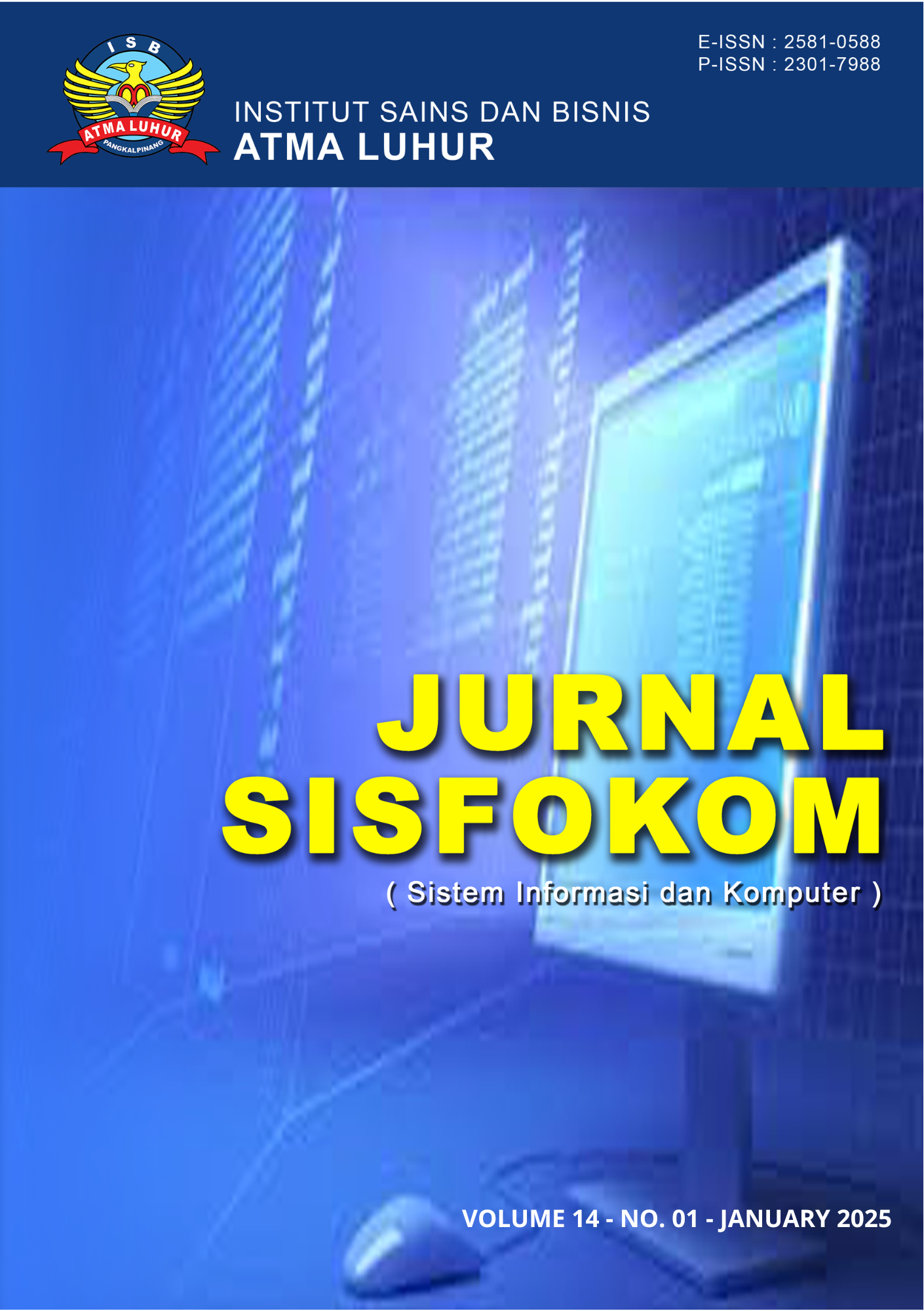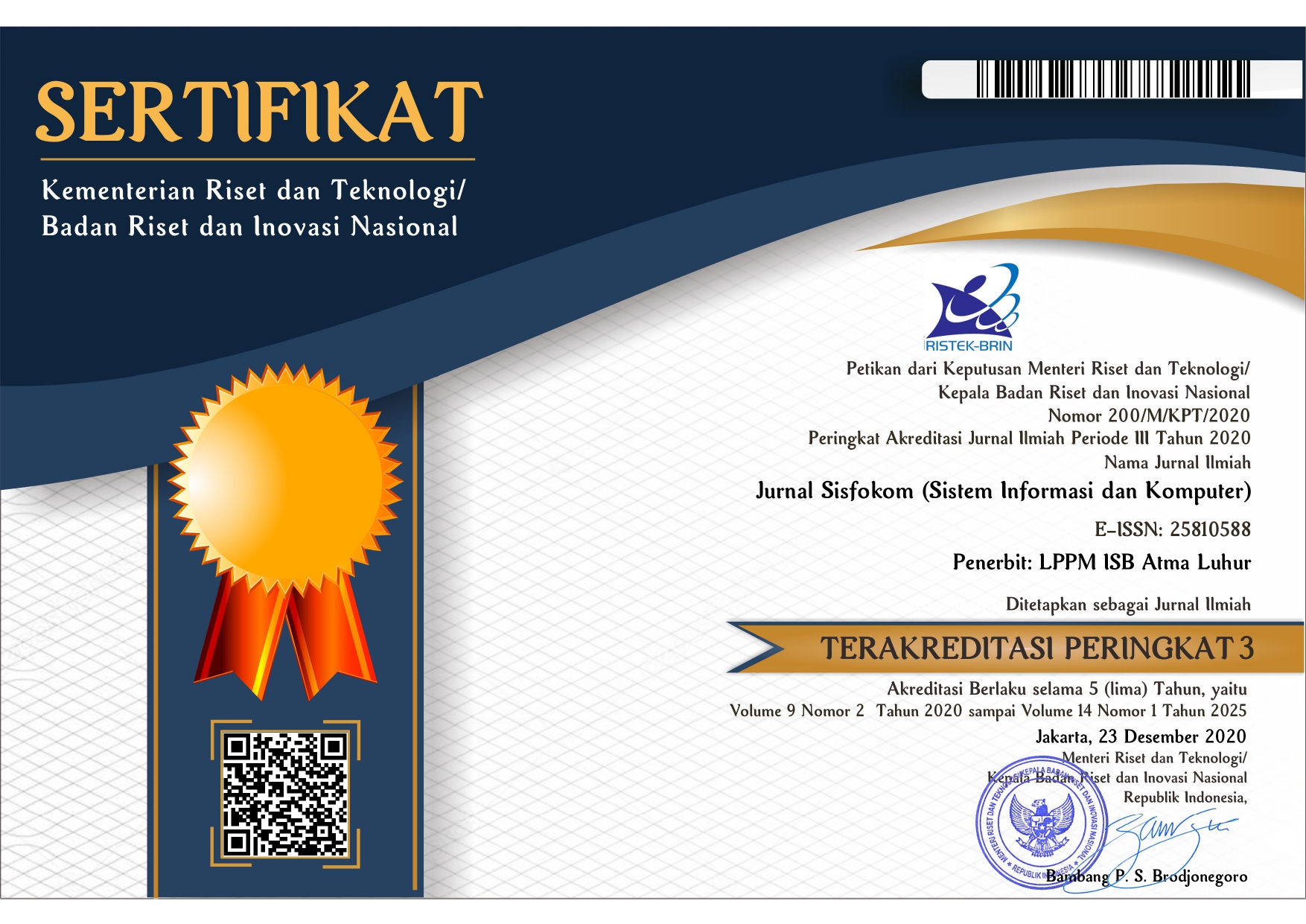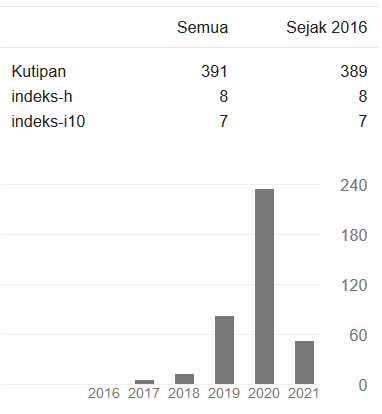Evaluating GRU Algorithm and Double Moving Average for Predicting USDT Prices: A Case Study 2017-2024
DOI:
https://doi.org/10.32736/sisfokom.v14i1.2328Keywords:
Cryptocurrency, Forecasting, Historical Data, Jupyter Notebook, Machine LearningAbstract
The cryptocurrency market is highly volatile, requiring advanced analytical methods for accurate price forecasting. This study evaluates the effectiveness of Gated Recurrent Units (GRU) and Double Moving Average (DMA) in predicting USDT (Tether Coin) prices using historical data from 2017 to 2024, sourced from Investing.com. Implemented in Jupyter Notebook, the research explores the strengths of each method in analyzing market fluctuations and price trends. GRU, a deep learning-based recurrent neural network, processes sequential data using a gating mechanism, making it effective for capturing short-term price dynamics. DMA, in contrast, is a statistical method that filters market noise to identify long-term trends, making it more reliable for stable market conditions. Performance evaluation shows DMA achieving lower errors (MAE: 5.494, MAPE: 0.0339%) than GRU (MAE: 5.984, MAPE: 0.0369%), suggesting higher accuracy for trend-based predictions. However, GRU’s lower RMSE (8.531 vs. 8.715 for DMA) indicates better adaptability to sudden price fluctuations, making it more responsive to volatile markets. A hybrid approach combining GRU and DMA reveals their complementary strengths—DMA’s minimal bias (-0.0013% MPE) supports stable trend analysis, while GRU’s slight positive bias (0.0286% MPE) captures short-term fluctuations. Additionally, a comparison with Long Short-Term Memory (LSTM) demonstrates its superior predictive accuracy, outperforming both GRU (MAE: 5.98, RMSE: 8.53) and DMA (MAE: 5.49, RMSE: 8.72) with the lowest MAE (4.31), MAPE (0.027%), and RMSE (5.64), alongside minimal bias (MPE: 0.007%). This study highlights the need for integrating multiple forecasting techniques in cryptocurrency price prediction. While DMA is well-suited for stable trends and GRU excels in volatile conditions, LSTM outperforms both, reinforcing the effectiveness of deep learning for financial time-series forecasting.References
V. S. Bhilawadikar and E. Garg, “Investment attitude of millennials towards cryptocurrencies,” Soc. Bus., vol. 10, no. 4, pp. 383–410, 2020, doi: 10.1362/204440820x15929907056652.
A. Kiky and D. Saputera, “Investasi Cryptocurrencies. Bertahan dengan Kerugian Cryptocurrencies?,” J. Perspekt., vol. 21, no. 2, pp. 120–128, 2023, doi: 10.31294/jp.v21i2.15657.
M. Widyastuti and Y. B. Hermanto, “Cryptocurrency Analysis of Indonesian Market Education Facilities,” Int. J. Econ. Bussiness Account. Res., vol. 5, no. 2, pp. 534–546, 2021, [Online]. Available: http://jurnal.stie-aas.ac.id/index.php/IJEBAR/article/view/2321
D. N. L. Tobing, “Indihome Product Sales Forecasting with the Double Moving Average and Double Exponential Smoothing Methods on PT. Telkom Witel Sumut Pematang Siantar,” Formosa J. Sci. Technol., vol. 1, no. 8, pp. 1201–1222, 2022, doi: 10.55927/fjst.v1i8.2281.
M. Qamal, S. Hasan, and T. Wulandari, “Prediksi Jumlah Mahasiswa Baru Universitas Malikussaleh Menggunakan Metode Dma (Double Moving Average),” TECHSI - J. Tek. Inform., vol. 11, no. 3, p. 353, 2019, doi: 10.29103/techsi.v11i3.1491.
R. Dey and F. M. Salem, “Gate-Variants of Gated Recurrent Unit (GRU),” Midwest Symp. Circuits Syst. Inst. Electr. Electron. Eng. Inc., vol. 784, no. 2017, pp. 1597–1600, 2017.
H. Jdi and N. Falih, “Comparison of time series temperature prediction with auto-regressive integrated moving average and recurrent neural network,” Int. J. Electr. Comput. Eng., vol. 14, no. 2, pp. 1770–1778, 2024, doi: 10.11591/ijece.v14i2.pp1770-1778.
M. I. A. PRAMUDYA, “Penerapan Market Basket Analysis Menggunakan Proses Knowledge Discovery in Database (Kdd) Sebagai Strategi Penjualan …,” Repository.Radenintan.Ac.Id, 2022.
F. Sari, R. Fauziah, and H. D. EIIyany, “Prediction of Goods Stock System in Santi Electronic Shop With Double Moving Average Method,” JURTEKSI (Jurnal Teknol. dan Sist. Informasi), vol. 8, no. 3, pp. 375– 382, 2022, doi: 10.33330/jurteksi.v8i3.1765.
C. A. Anisiuba et al., “Analysis of Cryptocurrency Dynamics in the Emerging Market Economies: Does Reinforcement or Substitution Effect Prevail?,” SAGE Open, vol. 11, no. 1, 2021, doi: 10.1177/21582440211002516.
A. Ferreira, “The Curious Case of Stablecoins-Balancing Risks and Rewards?,” J. Int. Econ. Law, vol. 24, no. 4, pp. 755–778, 2021, doi: 10.1093/jiel/jgab036.
M. A. Fauzi, N. Paiman, and Z. Othman, “Bitcoin and cryptocurrency: Challenges, opportunities and future works,” J. Asian Financ. Econ. Bus., vol. 7, no. 8, pp. 695–704, 2020, doi: 10.13106/JAFEB.2020.VOL7.NO8.695.
D. Molitor, W. Raghupathi, V. Raghupathi, and A. Saharia, “Understanding Cryptocurrency,” Int. J. Blockchain Appl. Secur. Comput., vol. 1, no. 1, pp. 1–25, 2023, doi: 10.4018/ijbasc.331079.
J. Almeida and T. C. Gonçalves, “A systematic literature review of investor behavior in the cryptocurrency markets,” J. Behav. Exp. Financ., vol. 37, p. 100785, 2023, doi: 10.1016/j.jbef.2022.100785.
I. G. A. D. Perayunda and L. P. Mahyuni, “Faktor-Faktor Yang Mempengaruhi Keputusan Investasi Cryptocurrency Pada Kaum Milenial,” EKUITAS (Jurnal Ekon. dan Keuangan), vol. 6, no. 3, pp. 351– 372, 2022, doi: 10.24034/j25485024.y2022.v6.i3.5224.
J. Barth, P. Gardin, and B. Nguyen, “Stablecoins and short-term funding
markets,” 2023.
J. A. Ripto, “Penerapan Gated Recurrent Unit untuk Prediksi Pergerakan Harga Saham pada Bursa Efek Indonesia,” 2022, [Online]. Available: http://repository.ithb.ac.id/id/eprint/38/%0Ahttp://repository.ithb.ac.id/id
/eprint/38/8/1118032_Paper-TA.pdf
D. A. Aquinaldo, “Perbandingan Metode Multivariatif GRU dan VAR Berdasarkan Sentimen Investor dan Nilai Kurs Dollar Untuk Prediksi Harga Saham,” vol. 3, no. April 2005, pp. 10238–10257, 2023.
R. Rachman, “Penerapan Metode Moving Average Dan Exponential Smoothing Pada Peramalan Produksi Industri Garment,” J. Inform., vol. 5, no. 2, pp. 211–220, 2018, doi: 10.31311/ji.v5i2.3309.
K. Mahendra, N. Satyahadewi, and H. Perdana, “Analisis Teknikal Saham Menggunakan Indikator Moving Average Convergence Divergence (Macd),” Bimaster Bul. Ilm. Mat. Stat. dan Ter., vol. 11, no. 1, pp. 51– 58, 2022, [Online]. Available: https://jurnal.untan.ac.id/index.php/jbmstr/article/view/51602
Downloads
Published
Issue
Section
License

This work is licensed under a Creative Commons Attribution 4.0 International License.
The copyright of the article that accepted for publication shall be assigned to Jurnal Sisfokom (Sistem Informasi dan Komputer) and LPPM ISB Atma Luhur as the publisher of the journal. Copyright includes the right to reproduce and deliver the article in all form and media, including reprints, photographs, microfilms, and any other similar reproductions, as well as translations.
Jurnal Sisfokom (Sistem Informasi dan Komputer), LPPM ISB Atma Luhur, and the Editors make every effort to ensure that no wrong or misleading data, opinions or statements be published in the journal. In any way, the contents of the articles and advertisements published in Jurnal Sisfokom (Sistem Informasi dan Komputer) are the sole and exclusive responsibility of their respective authors.
Jurnal Sisfokom (Sistem Informasi dan Komputer) has full publishing rights to the published articles. Authors are allowed to distribute articles that have been published by sharing the link or DOI of the article. Authors are allowed to use their articles for legal purposes deemed necessary without the written permission of the journal with the initial publication notification from the Jurnal Sisfokom (Sistem Informasi dan Komputer).
The Copyright Transfer Form can be downloaded [Copyright Transfer Form Jurnal Sisfokom (Sistem Informasi dan Komputer).
This agreement is to be signed by at least one of the authors who have obtained the assent of the co-author(s). After submission of this agreement signed by the corresponding author, changes of authorship or in the order of the authors listed will not be accepted. The copyright form should be signed originally, and send it to the Editorial in the form of scanned document to sisfokom@atmaluhur.ac.id.









